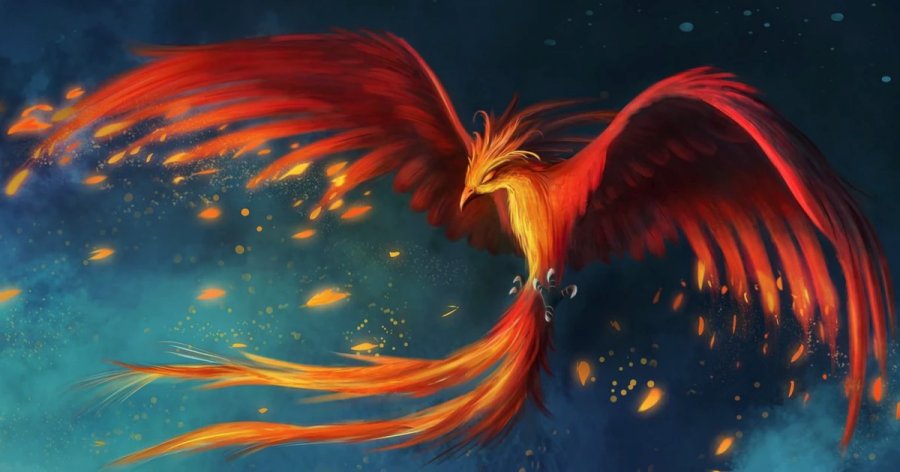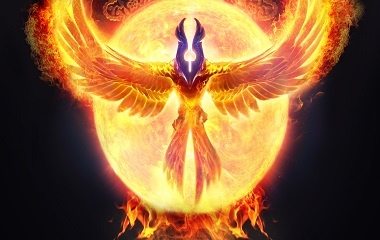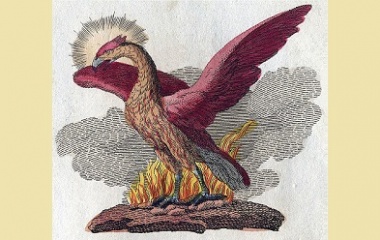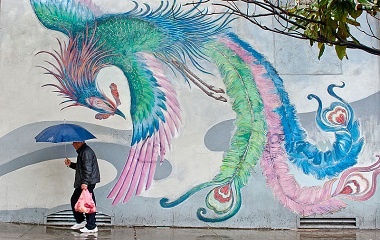What is A Phoenix?
The story of the Phoenix is legendary and is likely one of the most well known ancient myths in modern day. The legend is famous for the many elements it is said to concern – life and death, creation and destruction, even time itself is tied with the tale of the Phoenix.

The Phoenix was known to be a majestic bird-like creature that lived in Paradise. The Phoenix, like all other creatures who live in Paradise, was known to live a good life. It was a land of unimaginable perfection and beauty and was said to exist somewhere beyond the brilliance of the sun. However, in time, the bird began to feel the affects of its age. After 1,000 years had passed, it was ready to move on.
As the Phoenix was known to live in Paradise, it was also known that it could never truly die. However, it was possible for the creature to be reborn. As such, this is what happened in order for the creature to be born again.
The Rebirth of the Phoenix
First, the Phoenix flew west into the mortal world. It was necessary to come to leave Paradise and enter our world so that the creature could be reborn. It flew west until it reached the spice groves that grew in Arabia. It stopped there to collect only the finest herbs and spices (especially cinnamon) before continuing its journey to Phoenicia (which was likely named after the creature). Once the Phoenix reached Phoenicia, it built a nest of the herbs and spices it had gathered and waited for the sun to rise.
The next morning, when the sun god began to drag his chariot across the sky, the Phoenix would turn east to face him as the sun rose above the horizon. It would then sing one of the most beautiful and haunting melodies known to man – so perfect that even the sun god had to pause and listen to the sweet notes. When the Phoenix finished its farewell song, the sun god readied his chariots and continued his journey across the sky. This caused a spark to fall from the sky and ignite the nest of herbs and the Phoenix in flames. All that was left was a tiny worm.
This, however, was not the end of the cycle. After three days, a new Phoenix would rise from the ashes (supposedly transformed from the worm) and begin the next cycle of 1,000 years. It would carry the remaining ashes of its parent to the great Heliopolis and then return to Paradise until its cycle came to an end.
Alternate Variations of the Story
While the above tale is the most common version of the rebirth of the Phoenix, there are alternative versions that are also passed down. The first is that instead of flying to Phoenicia to end its cycle of life, the Phoenix flew to Heliopolis and gave itself to the fires of the sun city. From these fires, the new Phoenix emerges and then flies back to the land of Paradise.
There are also some versions where the Phoenix completes its journey as described above (from Paradise to Arabia and then Phoenicia) and then dies with the rising of the sun the next morning. The body begins to decompose (most versions of this story say this process lasts three days) and once it has reached the final stages of decomposition the new Phoenix emerges from the remains of the first.
Finally, a lesser known version of the story of the Phoenix claims that the Phoenix begins to show signs of age when it reaches the final years of its lifespan. It flies to the mortal world – losing many of its beautiful feathers and lovely coloration along the way. When it finished building its nest, it sets itself on fire (similar to the first version) allowing the next Phoenix to come forward.

The Burial Process
When the new Phoenix comes into the next cycle of life, the first thing it does is create a cremation egg to place its predecessor’s remains inside. To do this, the Phoenix flies off and begins to gather the finest myrrh it can find to form into a ball. It gathers as much as it can carry and then flies back to the nest it emerged from.
Once back at its nest, the Phoenix begins to hollow out the egg of myrrh and creates a small opening on the side so that it can begin to put its predecessors ashes inside. Once it has gathered all the ashes and put them inside the egg, it seals the opening in the cremation egg with myrrh and carries the remains back to Heliopolis. It leaves the remains on top of an alter in the temple of Ra and then begins its new life by flying back to the land of Paradise.
Where Does the Phoenix Live?
There are several variations on the tale of the Phoenix, but most versions say that the Phoenix resides in Paradise. This land is said to be a perfect world that was beyond the sun and was sometimes considered to be a representation of Heaven. However, there were also other versions of the story that gave other locations as residences of the Phoenix.
One location that was claimed to be the home of the Phoenix was the Heliopolis (city of the sun). This may be because the Heliopolis was where the Phoenix was entombed after death. In some versions of the story, this is also where the Phoenix was reborn.
The Greeks claimed that the Phoenix was known to live next to a well in Arabia. According to their records, the Phoenix bathed itself in the well every morning at dawn and sang a song so beautiful that Apollo himself (the sun god) had to stop his chariots in the sky to listen to the melody.
What Does the Phoenix Look Like?
The Phoenix was known to be one of the most beautiful and perfect creatures by those who recognized it – likely because the creature was associated with Paradise where all things are perfect. Most accounts of the Phoenix describe it as being red and yellow in coloration, though there are many variations. All that is known is that the appearance of the mighty bird was unlike any other and that it stood out because of is feathers.
In Greek mythology, there is also an association with the color purple – possibly because of their city, Phoenicia. The city of Phoenicia was known for their brilliant purple dyes that were used for royal robes. It is thought that giving this mythical creature the name ‘Phoenix’ is a way of referencing the purple coloration that could also be found in the bird’s feathers. Many works of art inspired by the Greek version of the myth show birds with brilliant yellow, red, and purple feathers.
There are also several variations on the eyes of the creature. Some sources claim that the eyes of the Phoenix are a brilliant shade of yellow, while others claim that they are like two shining sapphires.
All accounts of the bird emphasize the size of the creature, leading some to wonder if the Phoenix could have been inspired by a species of giant bird.
Additional Facts
There are also several variations in the myth of the Phoenix concerning the age at which the creature is reborn. Some legends claim that the bird lives up to 1,461 years, while others claim that the bird lived for 1,000 years. Other sources estimate the bird’s lifespan at a significantly smaller number.
Regardless of the version of the story that is being told, it appears that no records claim that the Phoenix dies before the age of 500 and the general cap for the life cycle of the mighty bird is typically less than 1,500 years. This can possibly be explained by the symbolism of the particular story in question and what the Phoenix was supposed to represent in the tale.
It was considered good luck in many cultures to spot a Phoenix. It was considered to signify that a good leader who was very wise had been given ruling power. It was also considered to be the sign of a new era.
The Phoenix was also known to have regenerative powers and was considered to be both invincible and immortal – excluding the end of its natural life cycle when it was necessary for the next Phoenix to be reborn. Because of this power, the Phoenix was known to be a symbol of fire and divinity that was often used by powerful leaders. The tears of the bird are also thought to have regenerative abilities that can be harnessed by humans. Additionally, new mythology concerning the Phoenix claims that it is impossible for a person to tell a lie if the creature is nearby.
Lastly, the Phoenix is known to have a different diet than the birds of this world. Instead of eating fruits and nuts, the Phoenix was said to have consumed frankincense and aromatic gums. It is unknown if this plays into to its impressive lifespan. The bird doesn’t collect normal herbs or spices until it is preparing for its cycle to come to an end and the new Phoenix to emerge. When it is time for this, the bird will gather cinnamon and myrrh to construct its funeral pyre, though it is unknown if it consumes either of these materials before its death.
Where Do The Legends of the Phoenix Come From?
While the majority of information that concerns the Phoenix can be found in Greek mythology, there are those who wonder if the ancient Egyptians are to credit for the origins of the story. This is due to the many similar elements of the story that can be found in each culture. In Egyptian mythology, there is a mighty bird named Bennu that is known to hold similar powers that are described by texts depicting the Phoenix. However, because of some confusion that surrounds the Egyptian texts, the origin of the story of the Phoenix is normally credited to Greek mythology.
Other Variations of the Phoenix
While the Phoenix is most commonly associated with Greek mythology, there were several other cultures that hold references to similar ‘solar birds’ or ‘fire birds’ that have often been compared to the Phoenix itself. The most commonly connected bird is the goddess ‘Bennu’ from Egyptian mythology who is almost identical to the Greek Phoenix. However, there are also similarities that can be found in Russian, Indian, Native American, and Jewish Mythology.
Bennu – Egyptian Mythology
The Greek Phoenix is commonly traced back to the Egyptian deity Bennu. The creature called Bennu was known to be a bird that was similar to a heron. Bennu was said to have lived on top of stones and obelisks and was worshiped by the people of ancient Egypt similar to the way in which Osiris and Ra were worshiped. In fact, it was thought that Bennu was a living symbol of the god Osiris.

Bennu was thought to have symbolized the flooding of the Nile which was known to bring wealth and fertility to the land. Because of this, she was one of the most respected creatures in Egyptian mythology. Additionally, the cycle of birth and rebirth is identical to that of the Phoenix (though the timeline is different). Instead of being reborn every 1,000 years, Bennu was reborn every 500 years.
Milcham – Jewish Mythology
Jewish mythology also makes references to a creature that is believed to be the Phoenix. In their version, the Phoenix is known as the Milcham.
The story begins in the days when people were still allowed in the Garden of Eden. It is said that when Eve gave into the temptations of the serpent and tempted Adam with the fruit, she also offered the fruit to the other animals in the garden. The Milcham bird was among the animals that refused to partake of the fruit and was therefore rewarded for its faithfulness. It was given a town where it could live its days out in peace eternally. Every 1,000 years, the Milcham bird would end one cycle of life, but being immune to the Angel of Death (because it had remained faithful to god) it would be reborn again.
Garuda – Hindu Mythology
Garuda is a solar bird that is known to be the mount of the god Vishnu and was also seen as a protector against the evil serpent. He is known to have been described as ‘the King of all birds’ and is often depicted as being a giant bird in mid-flight.
Thunderbird – Native American Mythology
The Thunderbird is also thought to have loose connections to the Phoenix. Similarly to Garuda, the Thunderbird is known to guard against the evil serpent figure and is thought of as a protector.
Firebird – Slavic Mythology
The Slavic Firebird has obvious ties to the Phoenix and was likely created in their folklore when the ancient cultures exchanged stories and legends on their trade routes. However, unlike many other cultures who told of the Phoenix, the Firebird was depicted as a giant falcon instead of a peacock. It is thought that this is because the falcon symbolized ultimate masculinity in the Slavic culture.
The Slavic Firebird was also different from the traditional Phoenix because of its life cycle. Their Firebird was meant to symbolize the different seasons. The bird finishes its life cycle in the fall months but is revived again in the spring. With its revival comes beautiful music that brings happiness and new life.
Ideologies that Adopted the Legend of the Phoenix
The myth of the Phoenix was not only common in ancient mythology, it was also adopted by several religions and was sometimes used to represent theoretical ideas and the reign of powerful kingdoms. The element of rebirth in the story has often been used to describe a wide range of ideas.
Symbolism in Ancient Egypt
Although the Phoenix was known as Bennu in ancient Egypt, the two mythical creatures have been identified as the same entity. In Egypt, however, the sign of the solar bird was used to symbolize of rebirth and immortality. The story of Bennu’s rebirth was thought to closely follow the rebirth of the human spirit as well.
Symbolism in Ancient China
The Phoenix was the symbol of the Chinese Empress and was also thought to represent feminine grace and the sun. It was considered to be good luck if a Phoenix was spotted. This was known to symbolize the ascension of a wise leader and a new era.
The Phoenix was also known to represent some of the most valued virtues like goodness, reliability, and kindness.
Symbolism in Christianity
In addition to being used in ancient cultures, the Phoenix is known to have been adopted into modern day as well. One such adaptation was made by the Christian religion.
The early Christians used the Phoenix to represent the terms of Christs death and resurrection. This connection can clearly be seen in the death of the deity (Christ or the Phoenix) followed by a period of three days, during which a rebirth occurred. After the third day, the new life cycle began.
The two ideas are so closely related that the Phoenix was used on early Christian tombstones to help symbolize the connection between the two figures. The images also serve as a reminder that death is not the end – it is simply a new beginning.
Cosmic Fire and The Creation of the Earth
The story of the Phoenix has also been hypothesized as a possible way of retelling the creation of the earth. Because the Phoenix is so closely related to the sun, there are some who would hypothesize that the birth of the Phoenix could also be the birth of a new world. This birth would result from a cosmic fire that could be symbolized by the bright colors of the Phoenix’s feathers, as well as the flames from which it arises.
When exploring this version of the story, it is often concluded that the death of the Phoenix describes the death of a world or galaxy through the explosion of its sun. However, this explosion is not the end of life, as it makes way for a new world to be created.
Metempsychosis
In Greek mythology, it is often thought that the story of the Phoenix is used to describe a philosophical term called ‘metempsychosis.’ This reflected the spiritual beliefs of many who lived in Ancient Greece.
Metempsychosis is known to be ‘the transmigration of the soul.’ This is the process in which the spirit of a person is reincarnated after death. The use of the Phoenix to symbolize this belief helps to explain that the soul of a person never really dies. It is simply transformed and rebirthed into another life as it moves from a person’s body in death and back to the Earth when it is ready to enter a new life cycle.
Possible Explanations for The Creation of the Phoenix Myth
The Flamingo of East Africa
There has always been much speculation into the inspiration of a creature as impressive as the Phoenix. Some hypothesize that the flamingo of East Africa could have served for at least part of the inspiration of the tale.
It is known that the flamingo of East Africa lives in an area that is too hot for its young to survive. Because of this, it has to build a mound of earthen materials in order to elevate its nest so that the eggs and hatchlings can survive the heat. It is said that the convection currents around the mounds created by this bird are similar to the movement of a flame – which could have been why the Phoenix was associated with fire.
Megafauna
There are also those who speculate that the story of the Phoenix was perhaps inspired by a species of megafauna that is no longer living. It is thought that the tale of the Phoenix then, could be an embellishment that described an actual species of bird.
Metaphorical Storytelling
The most common source that is credited for the inspiration of the Phoenix is simply metaphorical storytelling that was used to describe the spirituality of ancient cultures. Because many of the cultures that embraced the Phoenix were known to believe in the possibility of immortality through reincarnation (or transmigration), it is likely that the story of the Phoenix was created to give a more vivid description of the cycle of life and death.










great info, but I wished there was more on its behavior.
Actually it is also in Iranian Legends.
In Shahnameh (Book of Kings) of Ferdowsi it is mentioned.
this was not bad but I needed more info on paradise
helpful ty
thank you
awesome
Super helpful info